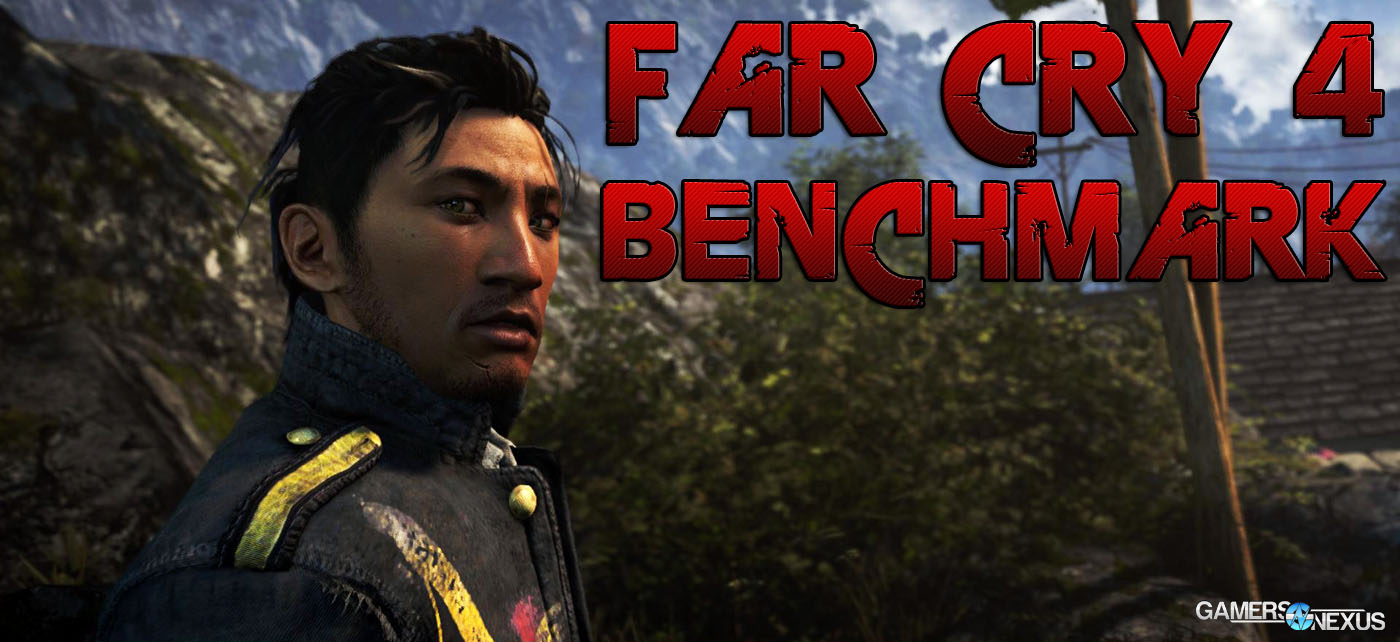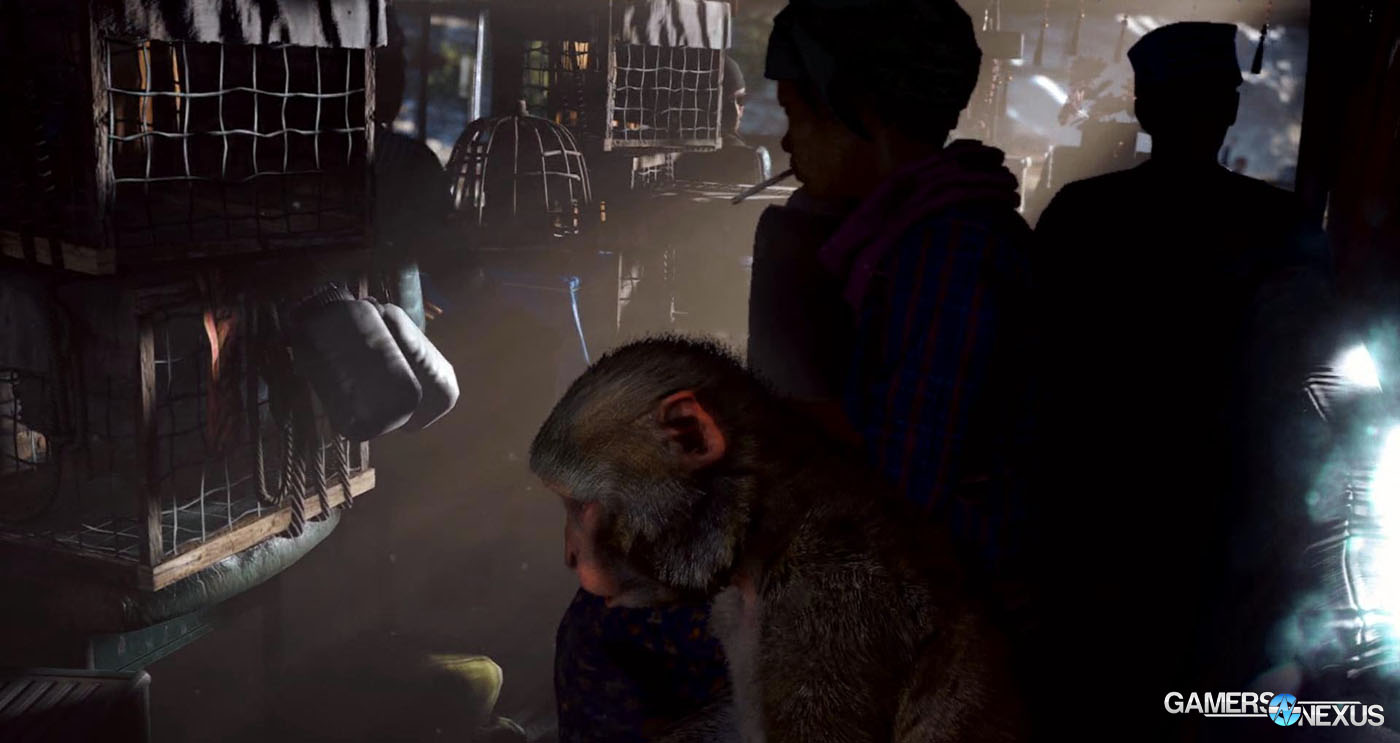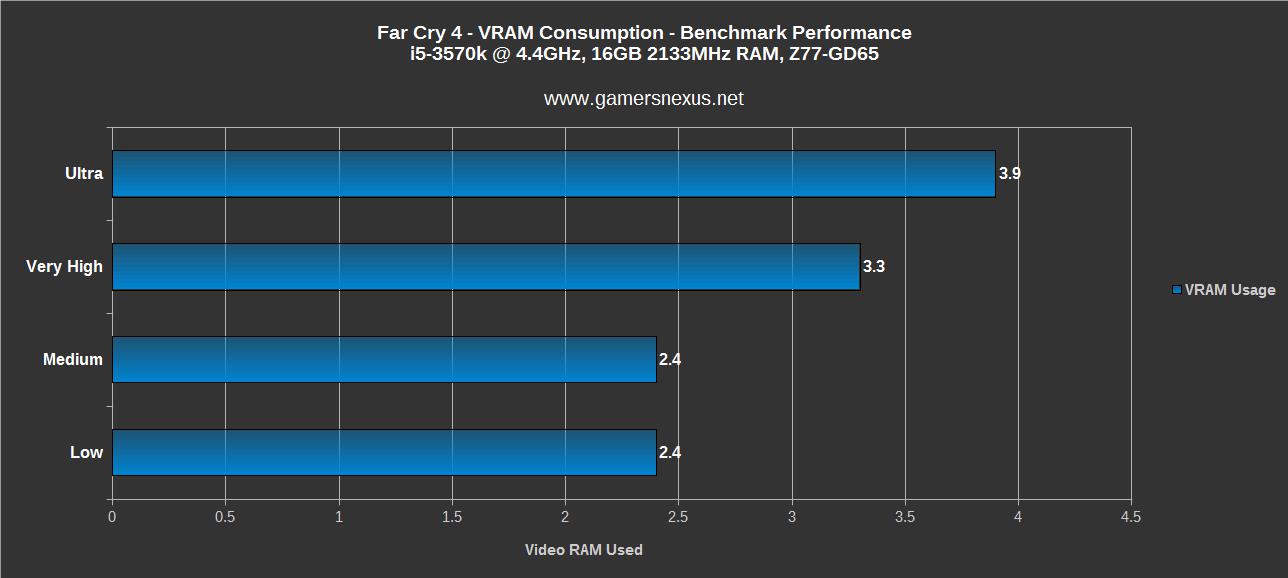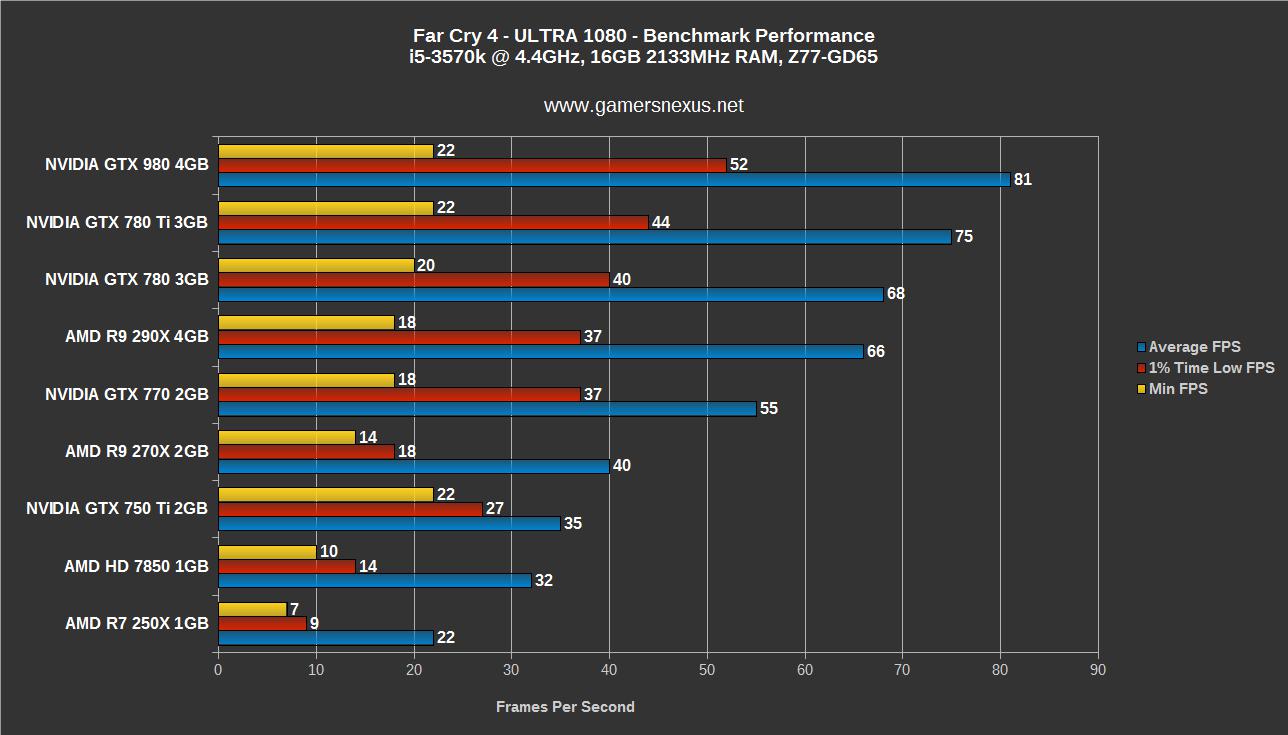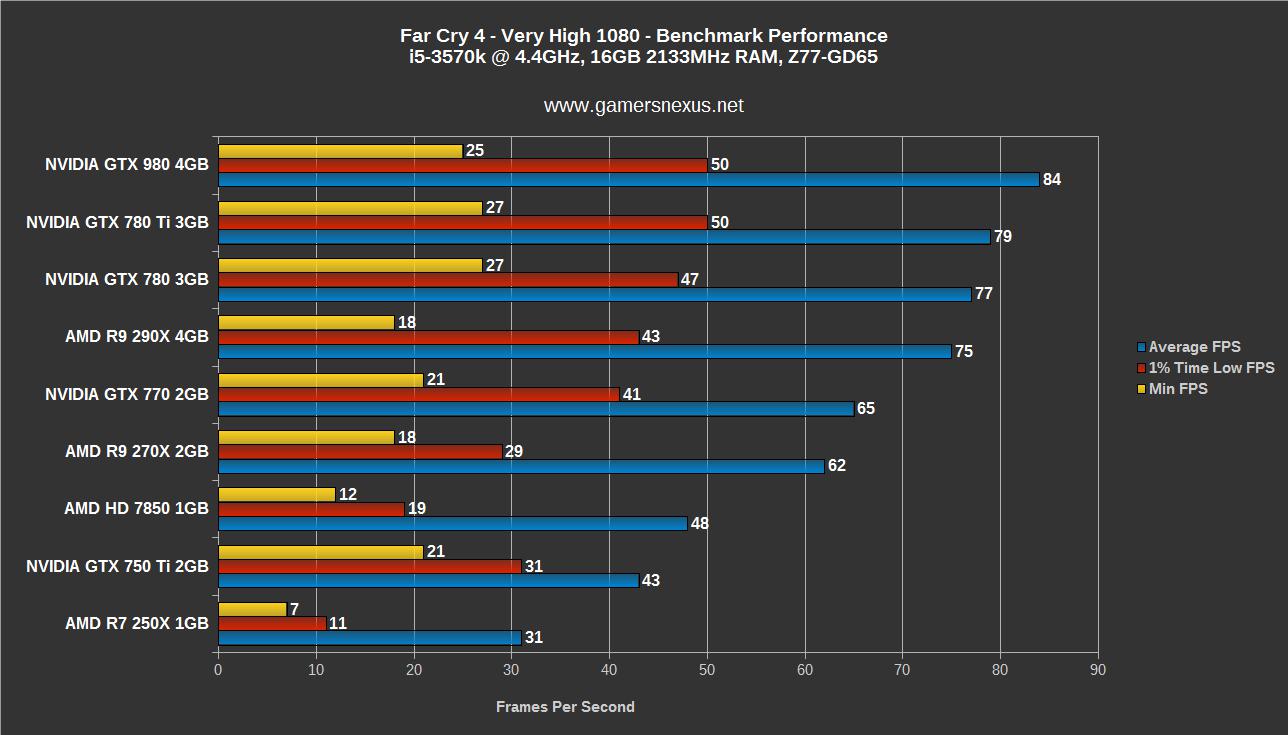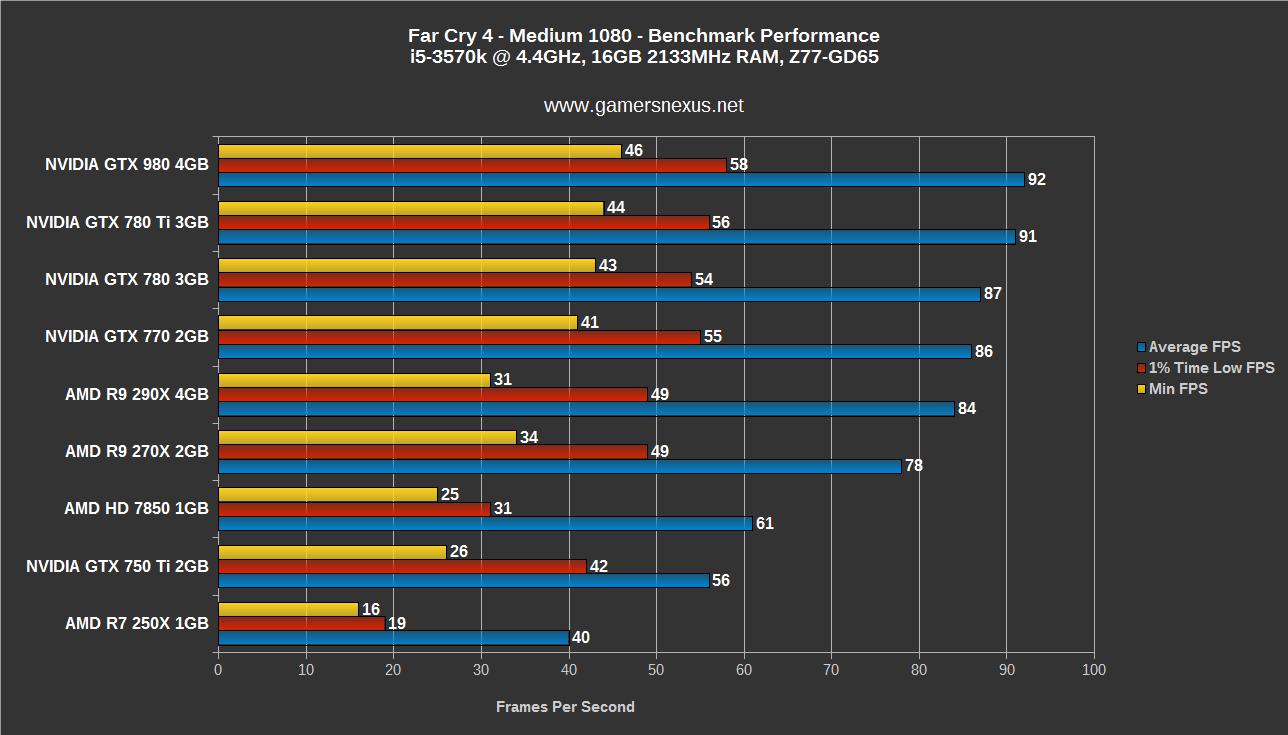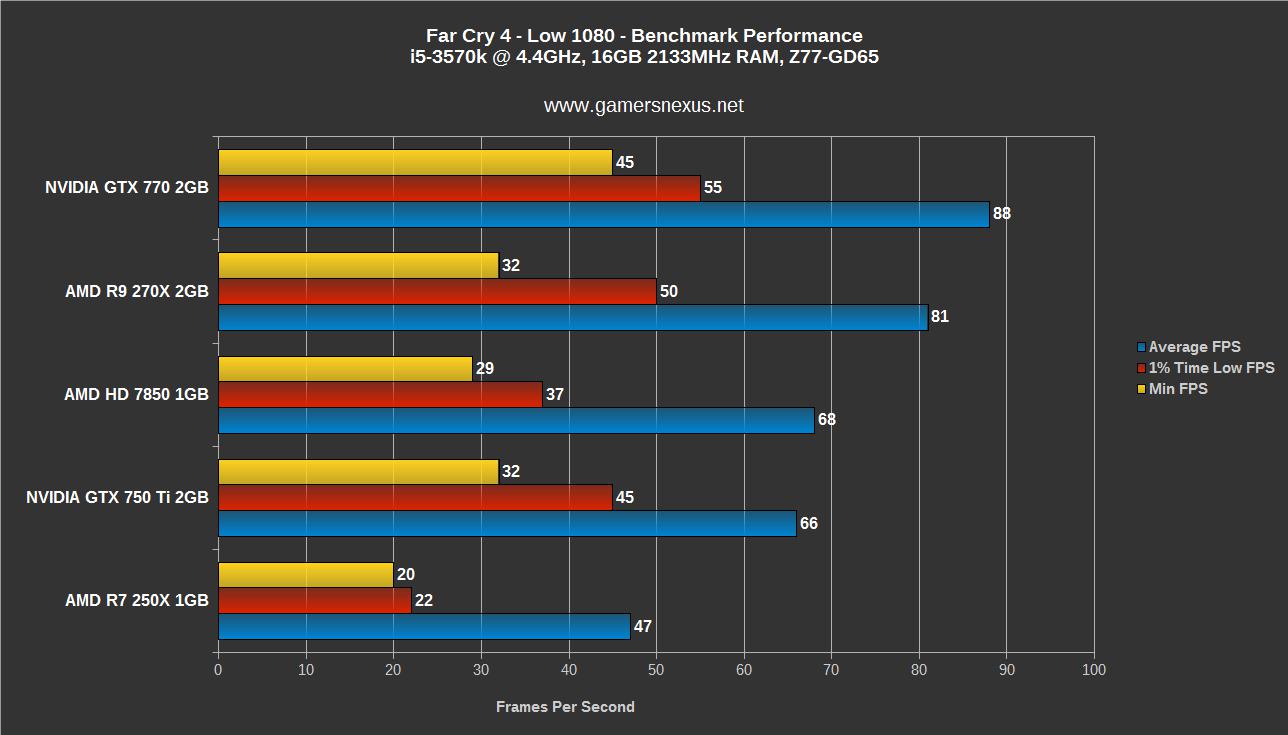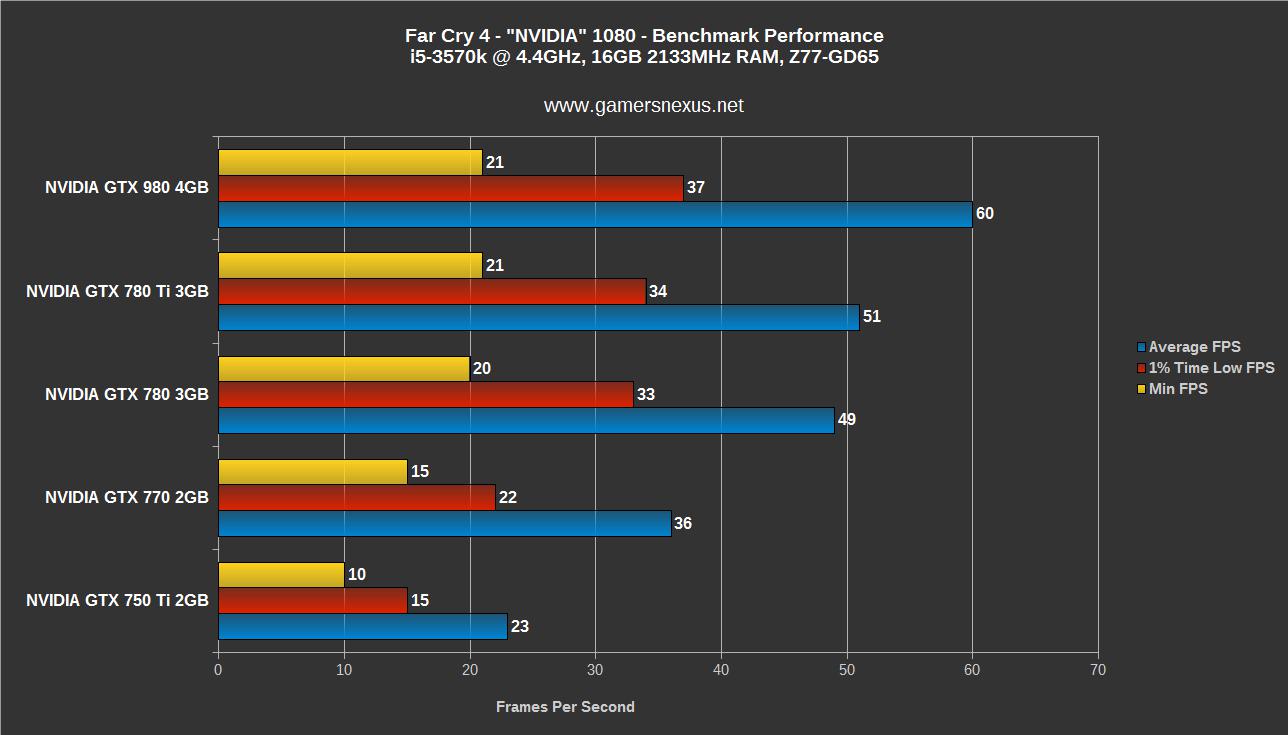Far Cry 4 GPU Benchmark – Unplayable on AMD, Ubi's Fault; GTX 980 vs. 290X, 770
Posted on
Ubisoft launched all its AAA titles in one go for the holiday season, it seems. Only days after the buggy launch of Assassin's Creed Unity ($60) – a game we found to use nearly 4GB VRAM in GPU benchmarking – the company pushed Far Cry 4 ($60) into retail channels. Ubisoft continued its partnership with nVidia into Far Cry 4, featuring inclusion of soft shadows, HBAO+, fine-tuned god rays and lighting FX, and other GameWorks-enabled technologies. Perhaps in tow of this partnership, we found AMD cards suffered substantially with Far Cry 4 on PC.
Our Far Cry 4 GPU FPS benchmark analyzes the best video cards for playing Far Cry 4 at max (Ultra) settings. We tested lower settings for optimization on more modest GPU configurations. Our tests benchmarked framerates on the GTX 980 vs. GTX 780 Ti, 770, R9 290X, 270X, 7850, and more. RAM and VRAM consumption were both monitored during playtests, with CPU bottlenecking discovered on some configurations.
Update: For those interested in playing Far Cry 4 near max settings, we just put together this PC build guide for a DIY FC4 PC.
Far Cry 4 Max Settings ("NVIDIA" / Ultra) Gameplay & Benchmark
(Note: We just published our Far Cry 4 crash fix guide over here).
Far Cry 4 Graphics Technology
Unlike Assassin's Creed Unity, Far Cry 4 ships with significantly less graphics fanfare on the PC front. The game looks great, but it's not necessarily boasting or inventing any new technologies.
Far Cry 4 saw partnership with nVidia, creating a heavier focus on soft shadows (similar to ACU's PCSS inclusion) and lighting effects. Soft Shadows are more GPU-intensive than other shadow settings because they are softened toward the edges, appearing more realistic as the shadow fades to natural light. Soft Shadows bleed light through the edges, the end result being less “hard” lines without transition between a cast shadow and the environment.
Other than this, god rays see heavy graphics emphasis and are optimized for nVidia devices. The god rays are implemented in a way that, when fully-enabled in the graphics settings, have tremendous atmospheric impact and are visually impressive.
AO technologies make an appearance, as always, but there's nothing new on that front.
We also see TXAA availability for nVidia devices (up to 4x), with other AA options including MSAA 4-8x and SMAA.
Test Methodology
The above is a video overview of our benchmark course. Follow the same path to replicate our tests. The video shows Far Cry 4 at max settings (Ultra / “NVIDIA”) with soft shadows, HBAO+, and TXAA 4x at nearly 60FPS / 1080p. (Note: the video was still uploading at time of publication, but should be online shortly). Note that some of these technologies were disabled during comparative tests between AMD and NVIDIA, ensuring a more consistent benchmark.
We ran an identical 120-second circuit in Far Cry 4's first village for each test.
For analysis of VRAM consumption, we logged GPU metrics using GPU-Z and analyzed them after the benchmarks. RAM consumption was analyzed with the native system resource monitor.
We tested Far Cry 4 on several video card configurations with a constant host platform. The Far Cry 4 FPS benchmark was conducted using several different settings within the game: a custom "NVIDIA-only" setting, a preset "Ultra" setting, and "very high," "medium," and "low" presets.
All tests were conducted three times for parity, each using a custom Far Cry 4 graphics benchmark course. We used FRAPS' benchmark utility for real-time measurement of the framerate, then used FRAFS to analyze the 1% high, 1% low, min, max, and average FPS.
NVidia 344.65 stable drivers were used for all tests conducted on nVidia's GPUs. AMD 14.11.2 beta drivers were used for the AMD cards.
| GN Test Bench 2013 | Name | Courtesy Of | Cost |
| Video Card | (This is what we're testing). XFX Ghost 7850 | GamersNexus, AMD, NVIDIA, CyberPower, ZOTAC. | Ranges |
| CPU | Intel i5-3570k CPU Intel i7-4770K CPU (alternative bench). | GamersNexus CyberPower | ~$220 |
| Memory | 16GB Kingston HyperX Genesis 10th Anniv. @ 2400MHz | Kingston Tech. | ~$117 |
| Motherboard | MSI Z77A-GD65 OC Board | GamersNexus | ~$160 |
| Power Supply | NZXT HALE90 V2 | NZXT | Pending |
| SSD | Kingston 240GB HyperX 3K SSD | Kingston Tech. | ~$205 |
| Optical Drive | ASUS Optical Drive | GamersNexus | ~$20 |
| Case | Phantom 820 | NZXT | ~$130 |
| CPU Cooler | Thermaltake Frio Advanced | Thermaltake | ~$65 |
The system was kept in a constant thermal environment (21C - 22C at all times) while under test. 4x4GB memory modules were kept overclocked at 2133MHz. All case fans were set to 100% speed and automated fan control settings were disabled for purposes of test consistency and thermal stability.
A 120Hz display was connected for purposes of ensuring frame throttles were a non-issue. The native resolution of the display is 1920x1080. V-Sync was completely disabled for this test.
A few additional tests were performed as one-offs to test various graphics settings for impact.
The video cards tested include:
- AMD Radeon R9 290X 4GB (provided by CyberPower).
- AMD Radeon R9 270X 2GB (we're using reference; provided by AMD).
- AMD Radeon HD 7850 1GB (bought by GamersNexus).
- AMD Radeon R7 250X 1GB (equivalent to HD 7770; provided by AMD).
- NVidia GTX 780 Ti 3GB (provided by nVidia).
- NVidia GTX 770 2GB (we're using reference; provided by nVidia).
- NVidia GTX 750 Ti Superclocked 2GB (provided by nVidia).
- GTX 970 4GB
- GTX 980 4GB
Far Cry 4 VRAM & RAM Consumption
We expanded upon our VRAM test from the Assassin's Creed Unity benchmark last week, now testing VRAM consumption on various graphics presets. VRAM consumption hovered in the ~3.5GB range when using high-end GPUs capable of Ultra settings. Even at the game's lowest settings, if VRAM was available for use, Far Cry would find ways to put it to use; we saw roughly 2GB VRAM consumed even on “low” settings, proving that larger framebuffers are rapidly becoming relevant.
As for system memory, the game uses about 1.6-1.9GB of system RAM at any given time.
Far Cry 4 Benchmark: GTX 980 vs. GTX 780 Ti, 770, R9 290X, 270X
Below are all of the graphs showcasing performance from our Far Cry 4 graphics card benchmark. The game was tested using these settings:
- “Ultra” preset with “enhanced” god rays.
- “Very High” preset without modifications.
- “Medium” preset without modifications.
- “Low” preset without modifications.
- “NVIDIA” preset for nV GPUs only.
We noticed CPU throttling as we approached lower settings with high-end GPUs. It seems that even a GTX 980 is incapable of pushing much further than 90FPS on Low settings, despite being capable of doing so. We suspect that this is due to our 3570K. A higher-end CPU may allow higher FPS.
Looking strictly at FPS and ignoring the next section, everything from the GTX 770 upward is capable of playing Far Cry 4 at 1080p with “Ultra” settings. The GTX 970 would fall right around where the GTX 780 is on our benchmarks.
Game-Breaking Stuttering, Frame Drops, & Choppiness on AMD
Far Cry 4 has fairly intensive graphics, but the game performs fluidly on all nVidia hardware. The fluidity with which gameplay unfolded meant that even nVidia devices pushing 30-40FPS were still more than “playable” in both input and visual output. AMD devices suffered horribly, though. Even with a 290X on medium settings, we experienced frame stuttering and choppiness (similar to what we saw in Watch_Dogs) that was jarring enough to be considered “unplayable.” Panning the camera left-to-right showcases the stuttering and frame drops, ultimately netting a somewhat nauseating experience on AMD GPUs.
We experienced this stuttering across all tested AMD devices, including the HD 7000-series card and rebrands (250X).
Owners of AMD devices should not purchase Far Cry 4 until further patches and driver updates are issued by both the developer and AMD. We tested with 14.11.2 beta drivers and Ubisoft's day-1 1GB patch, but know that updates are forthcoming.
Optimization is Great... for Half the Market
NVIDIA's cards run shockingly fluidly given the somewhat average framerates. Far Cry 4 is completely playable on a 750 Ti, though you'd want to drop settings a bit (probably close to “low”) for those scenes featuring explosives and high-action. The special “NVIDIA” preset game settings create an environment that features low-hanging fog, cloud-piercing god rays, and AA / AO that make for a beautifully-rendered game.
Unfortunately, none of this matters if you're on an AMD video card. The game is shamefully unplayable on AMD devices, to the point that I question whether Ubisoft even performed internal testing on AMD GPUs.
What's The Best Video Card for Far Cry 4?
After our testing, it's clear that AMD isn't even a consideration right now – at least, not until further patches and driver updates are released. Assuming a 1920x1080 resolution, you don't need too much in the way of video cards to run at moderate performance on very high settings. Some tweaking of settings will go a long way with Far Cry 4, allowing a GTX 760 or 770 to play the game nearly on very high / near-ultra settings with relative consistency.
Given the high VRAM consumption, we'd recommend a framebuffer of 3GB or larger.
My shortlist of solutions for Far Cry 4 would be:
- GTX 970 4GB ($400 – best performance-to-value at ultra settings / 1080p).
- GTX 980 4GB 4GB ($580 – best performance for “NVIDIA” settings or 1440p).
- GTX 760 4GB ($230 – hands-down the best value for Far Cry 4 if playing at high/very high on 1080).
AMD does not make the list until updates are issued by both parties, though I suspect that Ubisoft is more at fault.
- Steve “Lelldorianx” Burke.
